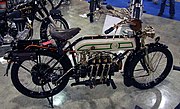History

The inspiration for arguably the first motorcycle was designed and built by the German inventors Gottlieb Daimler and Wilhelm Maybach in Bad Cannstatt (since 1905 a city district of Stuttgart) in 1885.[1] The first petroleum-powered vehicle, it was essentially a motorised bicycle, although the inventors called their invention the Reitwagen ("riding car"). However, if one counts two wheels with steam propulsion as being a motorcycle, then the first one may have been American. One such machine was demonstrated at fairs and circuses in the eastern U.S. in 1867, built by Sylvester Howard Roper of Roxbury, Massachusetts.[1]
In 1894, Hildebrand & Wolfmüller became the first motorcycle available for purchase.[2] In the early period of motorcycle history, many producers of bicycles adapted their designs to accommodate the new internal combustion engine. As the engines became more powerful, and designs outgrew the bicycle origins, the number of motorcycle producers increased.

Until the First World War, the largest motorcycle manufacturer in the world was Indian, producing over 20,000 bikes per year. By 1920, this honour went to Harley-Davidson, with their motorcycles being sold by dealers in 67 countries, until 1928 when DKW took over as the largest manufacturer.
After the Second World War, the BSA Group became the largest producer of motorcycles in the world, producing up to 75,000 bikes a year in the 1950s. The German company NSU Motorenwerke AG held the position of largest manufacturer from 1955 until the 1970s.

In the 1950s, streamlining began to play an increasing part in the development of racing motorcycles and held out the possibility of radical changes to motorcycle design. NSU and Moto-Guzzi were in the vanguard of this development both producing very radical designs well ahead of their time.[3] NSU produced the most advanced design, but due to the deaths of four NSU riders in the 1954–1956 seasons, they abandoned further development and quit Grand Prix racing.[4] Moto-Guzzi produced competitive race machines, and by 1957 nearly all the GP races were being won by streamlined machines.[citation needed]
From the 1960s through the 1990s, small two-stroke motorcycles were popular worldwide, partly as a result of East German Walter Kaaden's engine work in the 1950s.[5]
Today, the Japanese manufacturers, Honda, Kawasaki, Suzuki, and Yamaha dominate the motorcycle industry, although Harley-Davidson still maintains a high degree of popularity in the United States. Recent years have also seen a resurgence in the popularity of several other brands sold in the U.S. market, including BMW, KTM, Triumph, Aprilia, Moto-Guzzi and Ducati.
Outside of the USA, these brands have enjoyed continued and sustained success, although Triumph, for example, has been re-incarnated from its former self into a modern world-class manufacturer. In overall numbers, however, the Chinese currently manufacture and sell more motorcycles than any other country and exports are rising. The quality of these machines is asserted to be somewhat lower than their Japanese, European and American counterparts[citation needed].
Additionally, the small-capacity scooter is very popular through most of the world. The Piaggio group of Italy, for example, is one of the world's largest producers of two-wheeled vehicles. The scooter culture has, as yet, not been adopted widely in North America.[citation needed]


No comments:
Post a Comment